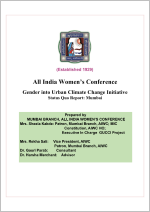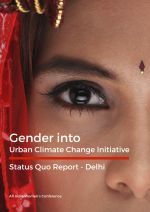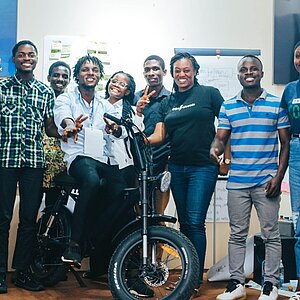Gender equality for effective climate and biodiversity projects

The International Climate Initiative (IKI) published its gender strategy in 2021. This strategy aims to support the inclusion and potential of all stakeholders and, in so doing, contribute to a social transformation.
The impacts of climate change and biodiversity loss are affecting all countries, societies and ecosystems. Among other things, the vulnerability of human populations to these trends also depends on socioeconomic, demographic and social factors. Gender is a crucial variable here: it strongly influences the degree to which the impacts of climate change and biodiversity loss are experienced while also affecting a range of perspectives and knowledge of appropriate coping strategies.
Combining biodiversity conservation with indigenous and local knowledge

Often, the use of ecosystem services such as collecting firewood, foraging for food or fishing is assigned according to existing gender roles. Crucially, these activities have given rise to nuanced, locally specific knowledge that is intimately linked to these resources. This can relate to healing properties or the distribution of certain species of plants, for example. This kind of knowledge is essential for the effectiveness of biodiversity conservation measures. Failing to take this into account can lead to situations where these measures prove inadequate or even unintentionally prevent certain groups from using natural resources.
One example from northwest Colombia illustrates another aspect. This region is populated by indigenous and Afro-Colombian groups – societies in which women play a leading role as guardians of knowledge about the cultivation of foods and plants. Their knowledge and skills are essential both for ensuring sustainable land use planning as well as increasing climate resilience for local communities. In these indigenous communities, women are encouraged to participate in decision-making processes about the use of natural resources, which secures the long-term protection of local biodiversity.
Sustainable mobility: combining greenhouse gas mitigation with social justice

Socio-economic, demographic and social factors are equally important when it comes to considering how human populations are altering the climate and biodiversity. For example, these factors influence which natural resources are used, who has access to those resources, and how high the resulting emission levels are. Accordingly, climate protection measures must take into account as many perspectives as possible, including gender aspects.
Sustainable models for mobility aim to reduce emissions in the transport sector. While public transport services play a key role here, the solution is not merely to have more buses or trains running or to establish new routes.
As findings from India demonstrate, the use and access of various means of transport is not gender-neutral. More women than men use public transport and also complete many journeys on foot. This trend is even more pronounced in economically challenged population groups. In more prosperous communities, men are more likely than women to travel by car.
For women and LGBTIQ* individuals, however, using bus or rail services is significantly less safe than it is for heterosexual men, since they are more often exposed to discrimination and sexual harassment. Safety is therefore a key element when making decisions for or against certain forms of transport. Among other aspects, women may well decide against taking up better-paid employment opportunities if this would require an unsafe commute.
Where an opportunity exists for expanding public transport services in the context of sustainable mobility, women must (at least) be accounted for in such plans as a vulnerable group and appropriate measures considered for public transport use. Ensuring the safe use of public transport by all groups in society can reduce emissions while promoting a general awareness of sustainable mobility.
Climate change, biodiversity loss and gender
Interactions between the negative impacts of climate change and biodiversity loss as well as gender roles and norms can be found in the following contexts, among others.
Contributions to climate change and biodiversity loss: The division of labour between genders affects the use of natural resources and therefore also has consequences for the climate and biodiversity.
Level of impact: Women and other marginalised groups are more affected by the impacts of climate change and the loss of biodiversity. In most countries, for example, women have a central role to play in the subsistence economy. Their experience in coping with the impacts of climate change, such as heatwaves or drought, can help when developing suitable adaptation strategies.
Access to decision-making: Gender-specific perspectives held by decision-makers often lead to different kinds of policy or management measures being adopted. Yet only a diverse range of approaches can promote climate action and biodiversity conservation. Unfortunately, women, non-binary, intersex and trans individuals often lack the access to officials and institutions needed to make their viewpoints heard.
IKI Gender Strategy
Aiming to participate in a global, societal transformation towards climate action and the conservation of biodiversity, the IKI sees achieving gender equality as a central factor in its process.
The IKI first introduced measures to promote a systematic consideration of the impact of IKI project work on gender relations in 2017. Since November 2021, the IKI Gender Strategy has provided a high-level framework for supporting and fostering gender equality. It was introduced to a wider public at the 26th UN Climate Change Conference in Glasgow. This strategy requires IKI projects to be designed in a way that avoids gender-based disadvantages and discrimination. A targeted approach to accommodating context-specific gender relations aims to improve activities in relation to climate action and biodiversity conservation.
The overall aim of the IKI Gender Strategy is to contribute to gender equality in society and promote a minimum set of standards for the consideration of gender-related aspects by integrating corresponding measures into projects involving cooperation on climate and biodiversity at an international level. The IKI Gender Strategy defines the following five action areas for implementation:
- Governance, scope and reporting
- Standards for implementing organisations and process modifications
- Gender competencies (internal and external)
- Knowledge management and communications
- Resources and budget
The link has been copied to the clipboard
Contact
IKI Office
Zukunft – Umwelt – Gesellschaft (ZUG) gGmbH
Stresemannstraße 69-71
10963 Berlin
IKI Gender Strategy

The IKI Gender Strategy provides a high-levelframework to integrate gender equity in IKI as a factor at project and programme level.


















